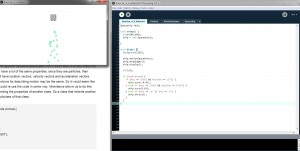Last couples of weeks I have worked on developing research ideas and planning out overall study procedures. This has been more specified after meeting with Prof. Ponto on Monday.
Given the time constrains, we decided to keep the overall procedure relatively simple for the STAR project.
This progress report 4 is organized as follows. First, I will discuss the series of behavioral data that can be measured and analyzed for the STAR project. Although original research plan was simply to compare shopper’s in-store behaviors in both 3D virtual store and actual store, I would like to develop the study further. On Monday meeting, we discussed other potential aspects to be examined in order to get the bigger picture of store design research. This would be what I will largely cover for the last half of this progress report.
The popularly accepted industry adage is that “unseen is unsold”. Consistent with this belief, retailers have developed the strategies to drag shoppers’ attention and expose them to more products. Suppose a shopper enters the university store to buy notebooks. When passing by electronics aisle, she remembers that her computer mouse got broken last week and need a new one. In-store stimuli such as products or promotion banners can guide shopper’s overall shopping paths as it triggers further wants and needs. Along these lines, for the STAR project, I would like to collect series of behavioral data that show how shoppers use physical products in the store as external memory cues that create new needs or trigger forgotten needs.
Specific plans for data collections are as follows.
In both conditions, participants will be asked to check the 3 product categories they planned to purchase during the current shopping trip. The main purpose of limiting the number of products in both conditions is to facilitate easier comparison in regard to the shopping paths deviation. However, this approach can invite some criticism. It would be necessary to think about valid reasons that can back up such manipulation.
| Actual store | 3D Virtual store | |
| Attention (Noting) | Fixation of head | Fixation of head or mouse |
| Approach | Move near to the product (distance) | Move near to the product (distance) |
| Examination | Pick up the item and checking the price | Instructed to click/point the item they want to examine |
Through meeting on Monday, we concluded that calculating reference/actual shopping paths can be rather complicated. In such case, we will compare the number of items that shoppers pay attention to, approach to and examine.
In order to develop this research further, I would like to examine other variables that can have impacts on in-store behaviors.
1) Store familiarity in terms of product location and layout
2) Shopping goal
The situation variable, shopping goal, affects in-store decision making in various ways. Along with the mind set and construal level theory, it is generally known that individuals who are in abstract state are more susceptible to environmental cues as undecided individuals do not know yet what they want to buy. Research consistently reports that shopper use physical products in the store as external memory cues that create new needs or trigger forgotten needs (Hui, Inman, Huang, and Suher, 2013; Inman and Winer, 1998; Park, Iyer and Smith, 1989). My central premise is that shoppers who are less certain of their goal would shop more, because they are more open to in-store stimuli and guided by external memory that triggers wants or needs. When consumer shops with concrete goal in their mind, product search should be guided by internal memory. In contrast, when consumers are not fully aware of what they want, search activities should be guided by external memory. This in turn will increase susceptibility to attractive marketing promotion for shopper.
With respect to shopping goal, I suppose following hypothesis can be tested in both actual and 3D virtual store.
Hypothesis 1: Compare to consumers who have concrete shopping goals, those who have abstract shopping goals browse and search product in a less selective manner.
Hypothesis 1a: Compare to who have concrete shopping goals, those who have abstract shopping goals pay attention to more diverse categories of products.
Hypothesis 1b: The probability that visual attention (noting) leads to following searching behavior (approaching and examination) is higher for consumers who have abstract overall shopping goal compare to consumers who have concrete shopping goals.
*) We also discussed the possibility of studying online shopping behavior. Surprisingly, there is no research that explicitly compare the searching behavior in offline and online shopping contexts to my knowledge. I will discuss it more about this on next post.
*) I got IRB reviews & comments. As it says that I need letter of permission to conduct the study at the bookstore, I got a signature from Duane and secured the permission today. I will be working on revising IRB for next couples of weeks.





